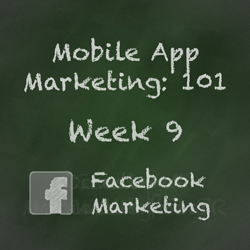From the mundane “Get Your Family to Download Your App” to the off the wall “Create Beer Coasters” join us on a 52-week journey of some of the top ways to promote and market your mobile application.
This month we are going to take a look at how to use social media to market your mobile app. Up for this week: It’s all about Facebook.
Week 9
Mobile Marketing Tips: Facebook Time

Social media has quickly become a key part of most marketing plans, and for many companies, it’s the only part. With email marketing quickly becoming over-saturated, everyone is turning to social media in order to broadcast what makes their products unique, whether it’s a car from GM or a donut from the local bakery. Amongst the many social media platforms, Facebook is undoubtedly one of the reigning heavyweights.
The Basics (and Beyond) of Facebook
I think everyone on the planet is pretty familiar with Facebook, what it does, and its immense popularity, so I won’t bore you with that. Likewise, there are books dedicated to Facebook marketing, so what I want to do is give you a quick rundown of what you can do on Facebook to help promote your app.
-
Create your page
You’ll notice that today we talk a lot about your “brand” page, we’re doing this to help keep confusion away from a Facebook “App” page which is completely different than what you’re trying to create to promote your mobile app. Before engaging in anything on Facebook you want to set-up your page. Wikihow has a great step-by-step walkthrough of how to actually create your page. The biggest keys are to make sure that you have a compelling cover photo, profile picture, and fill in all of the about information. Secondly, I’d suggest adding in screenshots of your app and picking a great name for your page (facebook.com/{Your-page-name})
-
Post Content worth Posting (And Sharing)
The exact formula that Facebook uses in order to display brand pages is a secret – however, it’s well-established that Facebook tends to display brand pages to people who often interact with the page. In other words, if a user tends to like, comment, or share content from a brand page, then the brand page pops up more often in their newsfeed. This formula is the same reason that you often see more posts from family members and close friends than distant acquaintances or coworkers. With that in mind, it’s critical that you post content your app users will want to see, not just what you’d like them to see. The more often your content is liked, shared, and commented on, the more often you’ll be seen in news feeds.
-
Create an Identity
Some companies or writers may caution you against posting content that is too colloquial, too informal, too “hip”. By and large, I would say this is nonsense. Facebook is where users go to hang out, talk, and interact with the people closest to them – they’re not going on Facebook to look at things or services they might buy. Accordingly, it’s better to speak to your potential users in the (textual and visual) language that they use with their friends. This is the language of memes, of pop culture, of references to things beyond your app and your brand.
-
Don’t Oversell
All things said, Facebook is more than an outlet for your press release or product announcement. Within a reasonable limit, Facebook is the place to post anything and everything that makes your app unique. This can mean news, photos, updates, videos, high scores in a game, how many users are using your app…literally, anything, so long as it’s (relatively) brand-appropriate.
-
Advertising can help
Facebook advertising is a great way to share your app with potential and current users. You can run ads that show up on the side of people’s newsfeeds as well as boost posts which can show whatever content you’re sharing with those not directly affiliated with you’re brand’s page. You can target people by demographic, what their interests are, what groups they belong to, and more. In the beginning, setting up Facebook campaigns is a great way to build a user and drive likes.
Tell Your Story, How You Can
As we’ve discussed in this blog post, and as we’ll see in blog posts to come, social media is all about storytelling. All marketing revolves around a story, whether it’s the story of your company, product, or service. In the same way that the same story receives a different treatment depending on whether it’s told through a book, a film, or a song, the story you’re trying to tell will need different approaches for each and every social media platform.
Next week we’ll take a look at crafting a strategy for the other giant of social media, Twitter.
As always, follow us on Twitter and Facebook to keep up.
The 52 Week Series of Marketing Mobile Applications
Week 1: Talk to Friends & Family
Week 2: Picking the Right Name for Your App
Week 3: App Store Optimization
Week 4: Submitting Your App to Review Sites, Blogs, and Directories
Week 5: Using Video to Promote Your App
Week 6: Creating a Microsite
Week 7: Creating a Press Kit
Week 8: Creating a Marketing Plan
Week 9: Social Media: Facebook
Week 10: Social Media: Twitter
Week 11: Social Media: Other Platforms
Week 12: Social Media: Managing Your Social Media Presence






